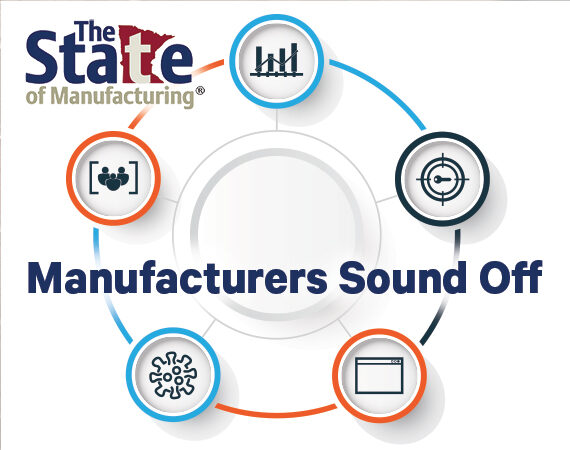Enterprise Minnesota spoke with manufacturers in 11 focus groups for the 2020 State of Manufacturing® survey. The following quotes are highlights from those conversations. For full focus group transcripts, please visit our State of Manufacturing page.
Let’s just start with the elephant in the room, which is the impact of COVID on your business. How has it impacted your ability to work profitably in 2020?
“It’s a matter of our customers canceling POs early on and extending orders. We’re working three to four days a week, depending on customers, but we’ve laid no one off and orders now seem to be holding steady.”
Were your customers reacting to worry about what might happen with COVID?
“Their world was drying up, and their inventories were building. So, they wanted to make sure they didn’t have excess of inventory, like what happened in 2009.”
“Because of DoD markets, we were, for the most part, blessed. They told us we had to keep rolling because construction can’t stop. The only way that we would have to stop is if there were COVID shutdowns due to illness. We had a few times where deliveries had to be rerouted because someone on the job site was sick, so the entire job had to shut down.”
So, if you look out from the beginning of 2020 to what you’ve experienced today, has COVID impacted your bottom line or is it more about adapting your processes to circumstances?
“Most of it’s been more procedural headaches, not necessarily bottom line. Moving forward, I’m a little leery on the outlook. Seems like bid lettings right now for the states have really slowed down. It seems like some of my competitors are getting things for dirt cheap.”
“This has had a couple of different impacts on our business. Our leadership group took another look at our forecasting for the year. Then we got to be closer to the first part of April, and we realized that the economists we listened to weren’t right. We started to see that our business was growing at a pace that we couldn’t catch up with, and still can’t. We were planning for about a 7% growth in 2020, and right now we’re sitting at about a 33% growth, and our lead times continue to creep out on us.”
What was your message to nervous employees who reached back out to you?
“They couldn’t see us panic. A lot of our organization went to working remotely, which made it very challenging and difficult to do business as usual. I think we transitioned very well. I don’t have all the answers for this stuff, and I still don’t to this day. I just do what we have to do and then try to keep our employees engaged so the trust factor relationship remains the same.”
Did you get any pushback from employees about the necessity of masking?
“For sure. I would say generally people are mostly compliant, but, depending on how they view the pandemic and how they view the risk of the situation, that varies from person to person. I would say for the most part, after a bit of an adjustment period, people have adjusted pretty well to the new requirements.”
(To an educator): How has all of this affected the relationship between manufacturers and technical colleges?
“Actually, we haven’t missed much. We have great relationships with our local manufacturers and area industries. That really helped us graduate students last spring when we were in the stay-at-home order. So, a lot of our players took on students as interns or hired them early prior to graduation. And then we converted all those experiences back to their programs so that we could graduate many of our students despite the COVID disruption. Enrollment wise, we are one of the few schools that has pretty flat enrollment, which is good, given that average college enrollments are down over 7%. But unfortunately for us, in our manufacturing programs, we continue to see a decline in the number of students in our mechatronics, machine tool tech and mechanical drafting programs. The welding program’s off the charts. I’m not sure why, but welding is very, very strong. The other three programs continue to struggle in terms of turning their enrollment fortunes around.”
Are there differences in how you approach strategic planning compared to now and the Great Recession of 2009? Back then, we heard a lot of manufacturing executives talk about how a recession is a terrible thing to waste. They looked for opportunities to reposition their companies for when the economy bounced back.
“That’s a tough one. We kicked that around: How can we take advantage of different things? And then one of our bigger customers approached me within the last month. He’s got a big job in Chicago and needs to hit a certain level of diversity. And I am certified as a woman business enterprise. I took a look at it and said we can make some changes and adapt, maybe look at some different tooling. So, we are going to take this job. And like I said, hopefully that’s going to launch us into being able to do similar types of machining and fabricating that we haven’t done in the past.”
“We’ve taken the same approach as we did in 2009. We’ve increased our advertising. And we advertised strictly on this register to reach our OEMs and the engineers who are out there. We’ve positioned ourselves to reach new markets. And right now, compared to then, our RFQs are busier than ever, the engineers are having a hard time keeping up. That being said, we know that any awards we get today, we’re looking next year to be back to the 2019 level for sales because it takes that long to get tooling up and running.”
Are there opportunities to reposition your company that you didn’t foresee at the beginning of 2020?
“Well, we actually saw a little bit of a slowdown starting last fall. We thought this would be a perfect opportunity to get ISO 9001 certified. It was a very interesting process because all of our training from about March through the time we finished our certification here in August was all online, including our audit with the registrar. He was very cooperative and helped us get through that, even though we’d never met face to face.”
Was your attraction to ISO certification more from the management aspect of the 2015 standards or was it more to give you some marketing prestige with current and potential customers?
“It was actually two things. One was the marketing, definitely. But the other part is that I’m in a position where I’m the owner of the company, and I anticipate hopefully getting out of the company sometime in the next 10 years. I thought this would be an excellent opportunity to bring more individuals into the management process and just get everybody onboard with how things work in our management system.”
Were you right?
“It’s too early to tell on the marketing side. I’ve had a few of my existing customers who were excited to see that we were certified. I would definitely say that I’ve seen a lot of growth in our leadership team, just in their confidence in making suggestions and making the decisions in various aspects of their jobs, making leadership decisions.”
How has this impacted the availability of qualified workers?
“I would say it’s more intense. And part of it is the stimulus that the government issued. There are a lot of people who aren’t really interested in working right now. And part of you wants to say, well, then, I don’t want you anyway. But then the other part of you says, man, there are a lot of challenges out there, such as educating your kids from home and daycare and just all sorts of issues. But that certainly has complicated things because there are people who aren’t really either ready to go back to work, comfortable going back to work, or interested in going back to work. And actually, it’s been really fun, but it’s been challenging as well to try to find those people.”
“One of the interesting things about Alexandria is just how diverse we are in the different sectors of business. And so, while we have some sectors that are struggling with what COVID has brought and the closings and the cutbacks on capacities, we have other businesses that are thriving right now. They’re seeing a better year than they’ve seen in several years. And because of that, they’re desperately seeking workforce, and they’re just not finding it. It’s just not out there right now. And that’s been a struggle for quite some time, way pre-COVID, and we’re not finding an answer for that, unfortunately. So, many of them are just cutting back and taking on the amount of work they can do with the existing workforce. There’s potential for growth in several of our local businesses, and it’s workforce issues that are holding them back from that.”
Many of you are competing for employees in the same market. What are your attitudes toward
that competition?
“The challenge is to get them in the door. And one of the things that I’ve noticed since this whole thing has started, and I think somebody else mentioned a little while ago, is the stimulus and the incentives that were put out there for people to not seek employment has really hurt us. We were in a challenging job market anyway, not a lot of people to pick from.”
Is your ability to recruit employees different today than it was, say, a year ago? Are there different challenges? Do you have the same number of unfilled jobs in your plant?
“Depends on who you are. If you’re the customer, they don’t see it that way, but our lead times have extended, and through communications and things that are going on, people are just… I mean, it’s not just us, anybody who supplies anything to the building industry right now, it doesn’t matter if it’s a window or shingles, they’re all in the same boat. Obviously, people want their stuff when they order it, and they want it in their building, but we can only do what we can do. I mean, our capacity is what it is, and our demand is way higher than that.”
“Yeah. I’m facing the same issues, but the people who are working are working, and the ones who don’t want to work, don’t want to work. And it’s really hard to combat that alongside the labor shortage that we all know exists. But during this tough time, I capitalized on letting my employees know that I truly care about them and their families as well as the community. And I did that really in two distinct ways. For a couple of months, when COVID was really hitting hard and everybody was getting laid off in terms of spouses and whatnot, we didn’t lay anybody off. But actually, our typical workweek for our shop guys is 46 hours.”
“And I wanted to keep the morale up, wanted guys to feel that it’s worth being at work as an essential worker. So, during a couple of months, I raised our overtime rate and I allowed them to work really as much as they wanted because we had the backlog to support it. I was making sure that we were staying ahead of things just because of the uncertainty of having to shut down or something like that. I also capitalized, in a way, by investing in the community through publicly announcing my pledge to treat my entire company, every employee, to a lunch once a week. And I rotated the restaurants in our community because they couldn’t always have people coming in their doors. I want our community to continue to thrive, and I support it by putting money back into the community. It was just word of mouth. I’m trying to invest in the fact that people in the community know we’re a quality company that takes care of our workers and the people around us. And it seems to have been paying off.”
Have the government unemployment payments ever worked as a disincentive for employees to apply for jobs?
“I’ve had people set up for interviews, and then the incentives went into place with the extra pay on unemployment, and yeah, they backed out last minute saying, ‘Yeah, never mind. I’m going to stay home.'”
How about revenues and profitability a year from today? Is forecasting more difficult because of the COVID economy?
“I don’t think it’s that much different than it’s been in the past. It really depends on how long this lasts, as far as folks staying home more and restaurants being at half capacity. I mean, that’s really driving the demand for us. So, if that lingers, our demand will continue to be strong, as the packaged food industry continues to have a strong demand. I think we’re looking at it to continue to be strong through next year. But again, it just depends on how quickly we get back to something closer to what was normal in the past. I think for a few years, the demand will still continue to be strong for us.”
“Actually, it’s a little bit harder just due to the uncertainty. Right now, we’re trying to figure out a little bit about our forecast, just because two of our largest customers were both hit pretty seriously with COVID-19. Both of them had plant-wide shutdowns for several weeks. And they still have a lot of absenteeism, which was seen in the orders. So, I think that’s the only unknown for us. It depends on how long COVID-19 sticks around.”
How optimistic are you about your ability to successfully plan for 2021 and to meet demand through the resources that you currently have?
“I don’t feel really good at all. I have a sick stomach. No, our team did not plan nor foresee this demand coming. This demand was, I want to call it, artificially made. I’m not sure if that’s the right word. I’m not really involved in the financial part of this business, but something had to do with the pandemic, the stimuluses, people’s abilities to access funds or however they got them to do home improvement projects that they normally probably wouldn’t have done. I can say this much: Between our leadership and leaders who granted equity, they’re really looking hard at how to plan as we finish up 2020 and move into 2021, setting our operations budgets and obviously forecasting for next year. Everybody’s being challenged to say, you know what, this is fake, this isn’t real, but we’ve got to try to figure out where that takes us next year. Will we just linger for another 18 months, or will it be over soon, as some people here jokingly say at the start of some meetings, when the election’s over? I don’t know. But from an operations side, to meet that demand, the only way it’s going to happen is if we as an organization are honest and forthright about what our true capacity is. We’re also landlocked. I mean, we need to add space. And that’s been a challenge too. In 2021, we’ll likely have a building expansion. Not because of the pandemic, but because we’ve outgrown our need and have really identified it these past six months.”
To read the full focus group transcripts, please visit our State of Manufacturing page.
…
Featured story in the Winter 2020 issue of Enterprise Minnesota magazine.


